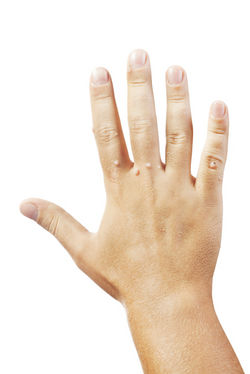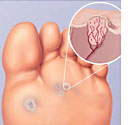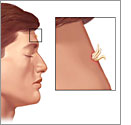Warts
|
Warts | |
| Causes | Infections, Sexual Contact, Hygiene |
|---|---|
| See Also | Dermatology / Skin Conditions, Respiratory Conditions |
| Books | Books on Skin Diseases |
| Articles | Articles on Dermatology / Skin Conditions |
Warts, also referred to as Verruca Vulgaris, are small, usually painless growths on the skin. They are typically harmless. In order to have warts you require contact with the Human Papilloma Virus (HPV) and individual susceptibility. Susceptibility to warts typically refers to a weakened immune system and area where the skin has been broken. The focus of naturopathic assessment and treatment is to identify and address your areas of susceptibility to decrease the chance of contacting or spreading the HPV virus.
Contents
Naturopathic Assessment
Warts are diagnosed by looking at the skin.
Causal Factors
Addressing the causal factors to warts is typically focused on identifying and decreasing those factors that increase susceptibility and those factors that are contributing to a weakened immune system.
Lifestyle
- Contact with the HPV virus is more likely if you have breaks in the skin.
- Some types of warts, such as filiform warts can be spread by sharing towels or products associated with facial use.
- Plantar warts can be easily spread in public areas such as pools, showers, bathrooms and gyms where people walk around with bare feet.
Social
- Contact
- Sexual contact spreads genital warts. It is important to follow safe sex guidelines to prevent the spread of the HPV virus.[1].
Environmental
- Infections:
- Warts are caused by the infectious agent HPV or Human papilloma virus which is found on the hands or soles.[2] The HPV virus infects skin and mucous membranes. There are over 150 different types of human papilloma virus. Some subtypes are associated with a particular typical location and characteristic presentation.
Related Symptoms and Conditions
Warts typically indicate disharmony elsewhere in the body or indicate a weakened immune system. Other considerations for those with frequent or persist warts:
- Immunodeficiency is associated with increased numbers and size of warts.[4]
- Warts are sometimes associated with skin cancer. [2]
Characteristics
- Warts normally occur in areas where the skin has been broken. Common areas include the hands, feet, knees, legs and face.
- It can take anywhere from 1 to 6 months from the time of first contact until a wart appears.
- Most warts will resolve on their own within 6 months.
- Warts are more common in children and teenagers with about 10% having warts at least once in their life,[3] but can occur at any age.
- Warts are commonly passed on to other areas of ones own body, but can also spread from person to person with prolonged and repeated exposure [1]
- Warts are normally skin colored and feel rough to the touch, but they can also appear dark and/or smooth.
Types of warts
- Common warts typically appear on the fingers or hands. These warts tend to be hard, rough bumps that are usually round in shape, raised above the skin and are flesh-colored. They are one of the most common skin conditions second only to acne. They are somewhat contagious and can be spread to other parts of the body.
- Plantar warts show up on the hands or soles of your feet. They are hard, rough growths than can be painful when walking. Plantar warts are typically benign and often disappear without any treatment. Treatment is advised when they are large or painful.
- Filiform warts are long, narrow protruding warts made up of multiple thin projectile-like growths. Filiform warts normally appear around the eyes, face, neck, mouth, lips and under the arms. This type of wart is usually benign. Filiform warts can have no symptoms or they can be itchy and bleed. Warts located in areas that are routinely rubbed or irritated can become infected, painful and spread to other areas.
- Flat warts appear in places where you shave frequently such as the face, underarms and legs. Flat warts are usually the size of the head of a pin, range in colour from pink, light brown or light yellow and can appear as one single wart or as a cluster with up to as many as 100 warts. These warts are usually painless unless they are located in an area that is continuously irritated. The more warts in the cluster often the more challenging to treat.
- Periungual warts are found under and around the toenails and fingernails. They appear as rough, irregular bumps and can affect nail growth by causing the nail to lift and/or partially detach. Because of their location they are more susceptible to infection.
- Genital warts (condylomata acuminata) are skin growths in the genital, groin and/or anal areas. They are a sexually transmitted disease that is very contagious and are spread by oral, vaginal or anal sex with a partner who is infected. They can appear in different shapes and sizes. Some look like smooth white skin growths, and others are rough and bumpy. It is estimated that approximately 2/3 of people who are intimate with an infected partner will get genital warts within a few months of contact. Genital warts are one of the most common sexually transmitted diseases affecting approximately 20 million people. There are 6 million men and women who contract genital warts every year. Some symptoms of genital warts include irritation, itching and bleeding. Genital warts can be different shapes and sizes.
- They can be very small or large.
- Warts may look like tiny bunches of rough "cauliflower-like" skin growths or like small flat, white areas.
- Genital warts may appear around the groin, the genitals, the urethra, or in the anus.
- In women, genital warts can appear on the vulva, vagina, or cervix and women are often unaware of these warts inside the vagina until a doctor finds them.
- In men, genital warts can occur on the outside of the penis and/or scrotum.
Naturopathic Treatment
The goal of naturopathic treatment is to support and work in tandem with the healing power of the body and to address the causal factors of disease with individual treatment strategies. A key aim of naturopathic medicine in the assessment and treatment of warts is to decrease a person's susceptibility by addressing those factors that are weakening the immune system and when dealing with a wart to speed healing time and prevent the risk of infection and/or spreading.
It is always advisable to work with a naturopathic doctor before engaging in any treatment plan.
Home Care
Home Care strategies include:
- Hygiene is critical in both preventing exposure, decreasing the risk of spread or infection.
- Avoid sharing towels and other cleaning products.
- Wash towels in hot water after use.
- wear shower shoes or swim shoes when you use a public pool, shower, bathroom or gym.
- Wash your feet with an anti-bacterial soap after being barefoot in a public area.
- Remember that warts can spread by contact. Be aware of the location of your wart and avoid unnecessary contact with others.
- Do not share utensils, straws, glasses or other items if someone has warts around the mouth.
To prevent contact or spread of genital warts:
- Use a condom when having sex or genital contact.
- Avoid multiple sex partners or high-risk sex partners.
- Avoid being sexually active before 18 years of age.
- Avoid sexual contact, especially with someone infected with HPV if you have an weakened immune system.
Lifestyle
Lifestyle recommendations include:
- Eliminate alcohol, caffeine and sugar.
- Identify and control food allergies and food intolerances.
- Consume a diet that focuses on whole unprocessed food (whole grains, legumes, vegetables, nuts and seeds).
- Water. Ensure you drink adequate water.
- Get regular exercise.
- Adequate sleep is important to support and strengthen immune health.
- Perform a relaxation exercise (deep breathing, meditation, prayer, visualization, etc,) 10 to 15 minutes each day.
Naturopathic Therapies
The prescribing of naturopathic therapies requires the guidance of a naturopathic doctor as it depends on a number of factors including the causal factors, a person's age, prescription medications, other conditions and symptoms and overall health. It is always advisable to work with a naturopathic doctor prior to taking any natural therapies.
Naturopathic Therapies for warts include:
- Clinical Nutritional Supplementation includes
- Botanical remedies such as Aloe (Aloe vera), Burdock (Arctium lappa), Echinacea (Echinacea angustifolia), Thuja (Thuja occidentalis).[5], [6]
- Garlic oil, fresh grated or crushed garlic or thuja oil.[7]Tea Tree Oil (Melaleuca alternifolia)
- Homeopathic remedies such as Causticum, Dulcamara, Sepia, Staphysagria, Thuja.[8], [9]
- According to Traditional Chinese Medicine, warts are caused by pathogenic wind, blood dryness and liver vacuity, external heat toxin invasion, or liver fire.[10]
References
Reviewed by Iva Lloyd, BScH, RPE, ND [1]
- ↑ 1.0 1.1 Berga S, Bowman M, Drossman D, Faling J, Frenkel E, Gabbard G et al. editors. 1992 The Merck Manual of Diagnosis and therapy 16th edition. Rathway: Merck & Co Inc
- ↑ 2.0 2.1 Aubin F, Laurent R. 2006 Human papillomavirus-associated cutaneous lesions. Rev Prat 15:56(17); 1905-13. PMID:17243389
- ↑ 3.0 3.1 Habif Thomas (2005) Skin Disease, Diagnosis and Treatment Elsevier Mosby.
- ↑ Kumar Vinay, Abbas Abul, Fausto Nelson, Mitchell Richard, editors. (2007) Robbins Basic Pathology 8th Edition. Saunders Elselvier, Philidelphia.
- ↑ Godfrey Anthony, Saunders Paul Richard, Barlow Kerry, Gilbert Cyndi, Gowan Matthew, Smith Fraser 2010 Principles and Practices of Naturopathic Botanical Medicine, Vol 1: Botanical Medicine Monographs, CCNM Press, Toronto
- ↑ Boon Heather, Smith Michael 2004 The Complete Natural Medicine Guide to the 50 Most Common Medicinal Herbs, Robert Rose, Toronto
- ↑ Traub M (1985) Dermatological diagnosis and natural therapeutics : an elementary manual. NCNM.
- ↑ Hershoff Asa 2000 Homeopathic Remedies, A Quick and Easy Guide to Common Disorders and their Homeopathic Treatments, Avery Publishing Group, New York
- ↑ Ullman Robert, Reichenberg-Ullman Judyth 1997, Homeopathic Self-Care, the quick and easy guide for the whole family. Prima Publishing
- ↑ Flaws B, Jian-Hui L (1993) A Handbook of Traditional Chinese Dermatology. Blue Poppy Press.



